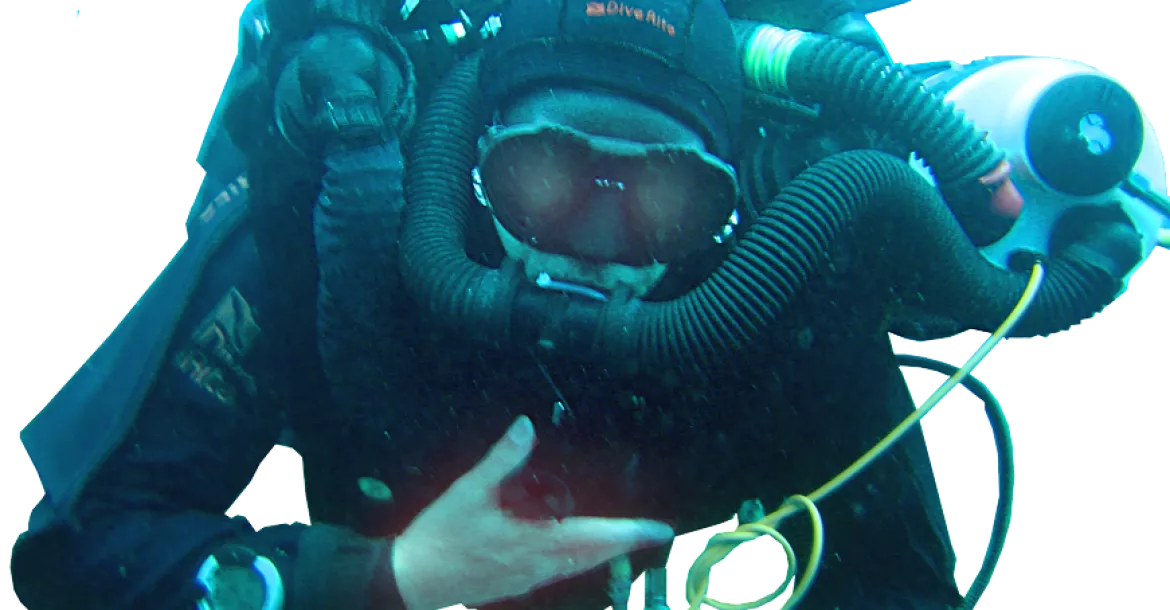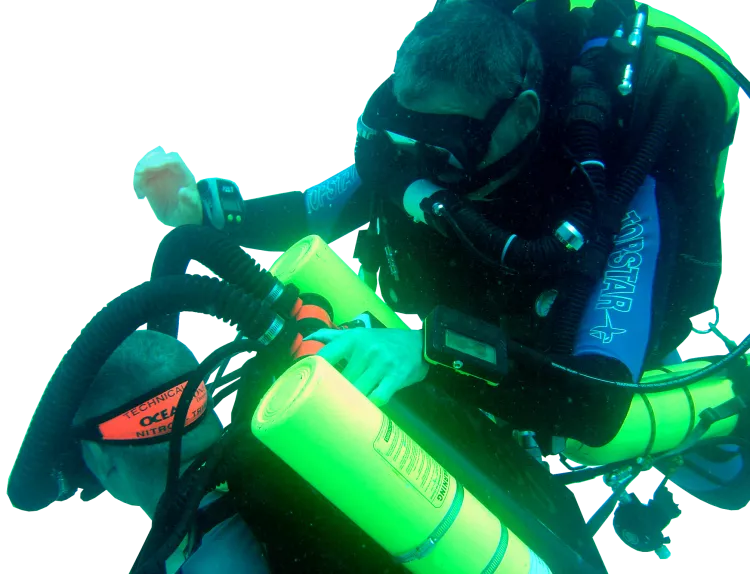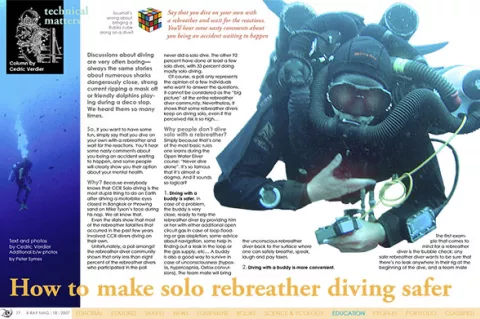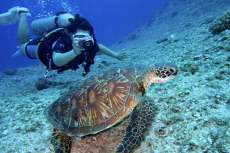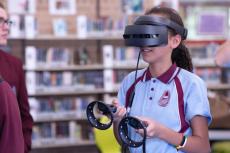Discussions about diving are very often boring—always the same stories about numerous sharks dangerously close, strong current ripping a mask off or friendly dolphins playing during a deco stop. We heard them so many times.
So, if you want to have some fun, simply say that you dive on your own with a rebreather and wait for the reactions. You’ll hear some nasty comments about you being an accident waiting to happen, and some people will clearly show you their option about your mental health.
Contributed by
Why? Because everybody knows that CCR Solo diving is the most stupid thing to do on Earth after driving a motorbike eyes closed in Bangkok or throwing sand on Mike Tyson’s face during his nap. We all know that.
Even the stats show that most of the rebreather fatalities that occurred in the past few years involved CCR divers diving on their own.
Unfortunately, a poll amongst the rebreather diver community shown that only less than eight percent of the rebreather divers who participated in the poll never did a solo dive.
The other 92 percent have done at least a few solo dives, with 33 percent doing mostly solo diving.
Of course, a poll only represents the opinion of a few individuals who want to answer the questions. It cannot be considered as the “big picture” of the entire rebreather diver community. Nevertheless, it shows that some rebreather divers keep on diving solo, even if the perceived risk is so high…
Why people don’t dive solo with a rebreather?
Simply because that’s one of the most basic rules one learns during the Open Water Diver course: “Never dive alone”. It’s so famous that it’s almost a dogma. And it sounds so logical?
1. Diving with a buddy is safer.
In case of a problem, the buddy is very close, ready to help the rebreather diver by providing him or her with either additional open circuit gas in case of loop flooding or gas depletion, some advice about navigation, some help in finding out a leak in the loop or the gas supply, etc… A buddy is also a good way to survive in case of unconsciousness (hypoxia, hypercapnia, Oxtox convulsions). The team mate will bring the unconscious rebreather diver back to the surface where one can safely breathe, speak, laugh and pay taxes.
2. Diving with a buddy is more convenient.
The first example that comes to mind for a rebreather diver is the bubble check: any safe rebreather diver wants to be sure that there’s no leak anywhere in their rig at the beginning of the dive, and a team mate is obviously very convenient to do that. He or she is also very handy when one needs to move a sling tank improperly clipped or remove a fishing line entangled with a tank valve.
3. Diving with a buddy is much more fun.
Being able to share some experiences, to plan a dive together, to take pictures of each other, to play stupid games during the long deco stops… there are so many examples showing why the buddy system has some clear benefits. And some people simply don’t like to be alone… or are afraid to meet a shark, a snake or Lord Voldemort’s Death Eaters.
So why diving solo with a rebreather?
If there still are some solo rebreather divers despite all the warnings you can read in most of the rebreather manuals, websites and forums, there should be some strong reasons for that. Some people think that buddies are not essential for a safe rebreather dive. A recent discussion on an Internet forum gives us some clues, as most of the rebreather divers who participated in the discussion don’t want to be buddied up with OC divers or incompetent buddies. And a few others simply dive in places where a buddy is useless.
Let’s have a look at the different factors.
1. Is diving with a buddy much more fun? It’s clearly a matter of personal preference:
The Open Circuit buddy
One of the problems a lot of rebreather divers have to face on a daily basis is the lack of rebreather buddies available. If you are the only rebreather diver on a boat, chances are that you’ll be buddied up with an Open Circuit diver. And that means short bottom time and a lot of noise all dive long. To be able to cope with your long bottom time, the Open Circuit diver will have to carry so many tanks that they will swim slower and will never be able to go through the restrictions as gracefully as you!
The annoying buddy
CCR or OC diver, your buddy could really be a pain in the neck. You may be one of those people who simply likes to be on their own. You like to go where you want, do what you want or change the dive plan the way you want without endless communication on the bottom. Being alone in the ocean surrounded by its creatures, exploring a fresh water cave or looking for artefacts in the silted-out room of a wreck.
2. Is diving with a buddy much more convenient?
Most of the things that are easier to do with a buddy can also be done on your own. It’s very often a matter of preparation:
- If you want to zip your dry suit alone, simply use a front entry zip.
- If gearing up your rebreather is a nightmare, use a bench at the right height, ask a member of the boat crew to help you or simply gear up at the surface if there is no current.
- How to check for bubbles in your back? You can use a small mirror or do a bubble check in a water tank or at the surface before you’re actually geared up.
- Even complex tasks like surveying a cave can be done by divers on their own. It’s just a little bit more time-consuming.
3. Is diving with a buddy much safer?
According to Bob Halstead, “Looking at some accidents and fatalities, it looks like buddies sometimes increase the risk of a dive, either directly through unpredictable or unreliable actions, or indirectly, through an unfounded belief that security is enhanced by numbers alone, regardless of the training or state of mind of the buddy.”
I saw CCR divers going much deeper than their level of experience would allow them, just because they felt safer with someone else with the same lack of experience and the same inability to react appropriately in case of emergency. The same persons diving solo would have been scared and would have been much more reasonable.
Sometimes, the buddy can even affect the safety of the dive by improper decision or behaviour, unsafe practice or lack of experience, excessive stress or panic.
Unfortunately very often, you see buddies that are incompatible, or spending their dives looking for each other. Some divers, who claim to be a team on the boat, ignore each other in the water. Others are over-dependant on their buddies or may fight in case of emergency; or don’t even recognize distress in their team mate. Stats are also full of divers left alone when a problem occurs, most of the time because their buddy simply panicked. Just being together is not enough.
Divers have to be able to recognize a problem and do something about it. Will an Open Circuit diver be able to recognize signs of hypoxia in their team mate and efficiently assist them by injecting some safe gas in the loop? Or to understand that a rebreather diver having trouble to slow down his breathing pattern maybe needs something else than simply stopping to swim?
Therefore, the buddy system works better if both members of the team are competent rebreather divers with similar experience, interest and equipment.
How to make solo CCR diving safer?
Theoretically, the buddy acts as a kind of safety factor. They are not essential, but have the purpose of preventing problems by recognizing them and stopping their development or performing a rescue. Therefore, being alone does not affect the risks of the dive (DCS, current, contaminated breathing loop, etc). You just don’t have the additional safety factor that a proper buddy could give you. However, don’t forget that an improper buddy might actually be an additional risk factor.
If you’re one of the rebreather divers who consider that in most instances, a competent solo rebreather diver is safer than the average buddy dive, is there any way to improve your safety?
1. Training
All rebreather divers should be trained primarily as self-sufficient divers during their basic rebreather course. But that’s often not enough to become a competent solo diver. So far, some training agencies designed specific courses for solo Open Circuit diving. There is no such thing for rebreather divers. And even if some other continuing education rebreather courses deal with that to a certain extent, none of them publicly endorse solo rebreather diving. A proper training course could help in really becoming self-sufficient by providing the student with more opportunities to practice some worst-case scenarios in a controlled environment and by adding more techniques to deal with any kind of emergencies.
Some basic techniques are worth being mentioned here:
- Avoid potential entanglement and entrapment situations.
- Avoid task loading (so no video unless conditions are perfect, no line laying, no Rubik’s Cube in a low visibility and high flow cave, etc).
- Run the dive well inside CNS limits possibly dropping the setpoint on deeper dives (it also gives more time to react to solenoid issues should they occur).
- At the surface have someone to double check equipment and dive plan.
- Take more time in the depth range 6-10m to make a final check on the rebreather and the bail-out and very carefully “listen to the body feelings”. After 2-4 min, if all checks okay, then go deeper.
- And remember that if something doesn’t seem right, go to OC.
2. Experience
Obviously, a lot of experience is required to properly start to dive on your own. Two things will come with experience: The ability to evaluate the risk of a specific dive, and the ability to solve the problems with a lower level of stress. When one has dived in many different environments, it becomes easier to understand what could go wrong and to anticipate the potential problems. An experienced rebreather diver will also be able to stay calm while dealing with one of those problems, staying away from stress and panic, keeping their breathing rate quite normal.
Always stay on the safe side and be concerned about physical injury, collapses, pinches in closing doors or falling rocks, cramps and entanglement.
For complex dives either in ways of cave navigation, wreck penetration or deco and gas schedules, plan for a brain failure. Write down everything and double check all parameters before making any decision.
3. Equipment
Obviously, being able to come back to the surface in case of complete rebreather failure is necessary. Therefore, a bail-out option has to be thoroughly planned according to the dive parameters (depth, time, decompression obligation, current, etc). The Open Circuit (OC) option is still the most popular way. Unfortunately depending on the dive, the gas requirements soon become huge and the perfect bail-out rebreather has still to be designed. For the time being, only a handful of homebuilt rebreathers are available on the market, mainly used by cave rebreather divers.
The minimum equipment to be carried by a solo rebreather diver could be:
- Enough OC bailout (usually 150 percent of what is calculated need)
- A mirror/blank CD to check own gear if need be
- Two cutting devices at least, accessible with both hands
- A spare mask
- A spare reel and SMB (agree on colours prior to dive to indicate trouble)
- A spare computer and/or 2 sets of tables
- A back-up light (two in an overhead environment)
- A slate and an SMB to send up for communication with the surface support
Becoming unconscious, and the associated risk of drowning, is also a big concern in the rebreather diving community. It looks like more and more rebreather divers use Full Face Masks or neck straps to make sure that they will not loose their mouthpiece. Adding a Bail-Out Valve (OC/DSV) is also a way to quickly react to some situations like severe hypercapnia while avoiding (or delaying) the unnecessary stress to close the DSV and switch to another regulator.
But we still have the case of the unconscious rebreather diver, on the bottom, in a wreck or a cave, with the airway well protected by a FFM. This diver is still safe as long as he/she’s breathing and has some gas to breathe. But he/she could remain there, unnoticed, for quite a while before anybody at the surface starts to look for him/her, as it’s well known than rebreather divers have huge bottom times.
So what’s the solution to avoid this situation? Here are some ideas about procedures to increase the chance to have a rescue team looking for the solo rebreather diver early enough:
► For cave or shore dives:
► For Boat dive:
Having a rescue team quickly looking for you is a good thing, but it’s clearly better to be found quickly enough to be rescued. So, how to increase the chance for the missing diver to be quickly spotted and rescued by the other divers?
Emergency situations are maybe the most important issues to be addressed in order to make solo rebreather diving safer.
And even if you don’t want or don’t like solo diving, as soon as you dive in a tight cave, a low visibility quarry or inside a deep wreck, your buddy cannot do a lot to help you in case of emergency. You’re pretty much already a solo rebreather diver… ■
- Have a bubble watcher (there are always bubbles released during the ascent, even with a CCR!), give them a reasonable schedule for the dive and limit the dive to the planned time
- If no bubble watcher, leave a written, dated and timed plan with someone or on the car. Have someone expecting a phone call at the end of the dive.
time allowed per the plan, divers can start the search rather than delaying until after ascent and then realizing that someone is late.
- Have a maximum dive time after which the surface team moves to rescue mode.
- All divers can agree to be back at the shot by a precise time. Failure to meet up or a strobe left on the line would force a search.
- Always have one crew member in a diving suit ready to splash
- Take tagged clips to attach to the bottom of the line after descent, then to be removed when on the way to the surface. If someone doesn’t make the line by the maximum
- Always deploy lift bag/SMB when ascending. It makes the skipper’s life easier when it comes to follow each rebreather diver from the surface.
- If the wrong colour SMB surfaces, then the surface support splashes to see what is going on.
- Have easy-to-spot equipment. White is the best seen underwater. White stage Tanks. A white slate (outside at the tie-off point on a guideline in a wreck or a cave). White or yellow rebreather. Pink dry-suit ;-)
- Have a strobe attached to the back of the unit.
- Lay a line on the wreck and tag the line to minimize the search area.
- The rescue team should use a scooter for optimal coverage.
- Everyone has to be trained to rescue a rebreather diver (basic knowledge about procedures and rebreathers and first aid).
- Always have a dive light on when diving in low visibility, in a wreck or a cave.

